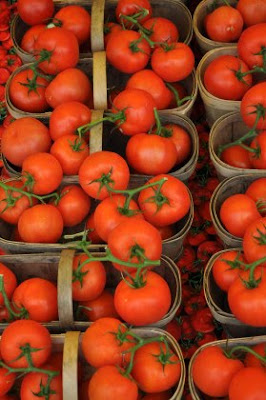I have a difficult time getting through the winter months.
This may have something to do with those nasty, four letter words; “snow” and
“cold”. If I ever chance to live in a warm tropical place, you will never here
me say; “I miss the snow”. Never, ever. I can guarantee that I would never
utter those words. If I lived in a climate that was more appropriate for
growing palm trees in the front yard instead of maples, the one month in Canada
I often think that October is Mother Nature’s way of trying
to make me feel better about the inevitable. My beautiful consolation prize for
the (brrr) winter months ahead. This feeling is especially true on those
gorgeous, mildly warm fall days, when the skies are blue, the sun is shining
brightly and the leaves on the trees are lit up in brilliant shades of orange,
red and yellow.
On crisp, cool October Saturday mornings at the local
farmers’ market, those gorgeous fall colours are also reflected in the produce.
Butternut squash, pepper squash, numerous varieties of apples, peppers, potatoes,
carrots; colour is everywhere. It’s so easy to get inspired to cook up
something warm and comforting. It’s been said that we eat with our eyes before
we taste our food and I believe that using colourful ingredients is key to
making the food we prepare visually appealing as well as flavourful.
The other night I made one of my favourite weeknight meals;
fresh arctic char, topped with slices of lemon, gold and red sweet peppers and
carrots; all the colours of fall. Everything is wrapped up in parchment paper,
like a little package, and baked in the oven. It’s such a simple meal to
prepare, but when it comes out of the oven and the “package” is opened, it
really looks like something special. Arctic
char is a cold water fish that’s part of the salmon family and is one of my
favourite choices for fish. The flesh is a lovely, light coral colour. The
taste is similar to salmon, but the texture is lighter and flakier. The
sweetness of the peppers and carrots are a perfect accompaniment to the fish.
The parchment packages go into the oven on a baking sheet and that’s the only
clean-up there is. No messy pans to wash up afterwards.
Arctic Char en Papillote – by Catherine Negus
Ingredients
2 slices of fresh lemon + additional lemon wedges for
serving
1 medium to large carrot
½ sweet red pepper
½ sweet golden pepper
approx. ½ tbsp. extra virgin olive oil
¼ tsp. dried tarragon
sea salt
freshly ground black pepper
Method
Set a rack in the middle of the oven and preheat the oven to
375 degrees F. For each “package”, you will need a piece of parchment paper
approximately 15” square. Peel the carrot and remove the top. Slice it
lengthwise in half. Set each half flat side down on a slicing board and slice
each half lengthwise in ¼” widths. Cut the carrots slices in half horizontally.
Remove the membrane and seeds from the sweet pepper halves and slice each half
lengthwise in ¼” slices.
Place a fish fillet in the center of the piece of parchment.
Season the fish with sea salt, freshly ground black pepper and little dried
tarragon. Set two slices of fresh lemon side by side on top of the fish. Carefully
stack the carrot and sweet pepper slices on top of the fish and drizzle with
the extra virgin olive oil. (If you have too many slices of carrot and peppers
to rest easily on the fish, save them for nibbling later.)
Each fillet has two
shorter length ends and longer sides. On the longer sides, draw up the sides of
the parchment and bring them together. Holding the sides of the paper together
at the top, fold them down about ¾”. Using this fold as your guideline, keep
folding the paper over and over in the same direction until you have reached
the top of the vegetables. Tuck the ends of the paper underneath the package.
Set the prepared packages on a baking sheet and bake for about 30-35 minutes, until the parchment has lightly browned on top. Using a spatula, remove the parchment packages from the oven and serve on dinner plates as is. Unroll the parchment packages carefully as there will be steam that escapes. Serve with wedges of lemon.


















































